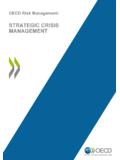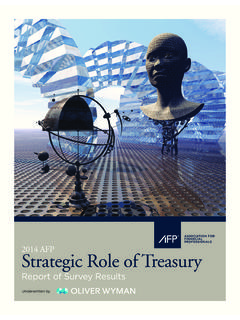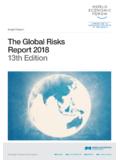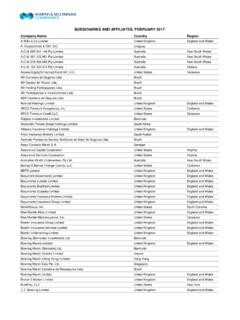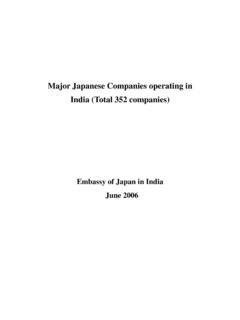Transcription of Cyber Handbook 2018 - Marsh & McLennan …
1 MMC Cyber . Handbook 2018 Perspectives on the next wave of Cyber FOREWORD. Cyber risk continues to grow as technology innovation increases and societal dependence on information technology expands. A new and important turning point has been reached in the struggle to manage this complex risk. In the war between Cyber attackers and Cyber defenders, we have reached what Winston Churchill might call the end of the beginning.. Three characteristics mark this phase shift. First, global cybercrime has reached such a high level of sophistication that it represents a mature global business sector illicit to be sure, but one which is continually innovating and getting more efficient. In 2017 we have experienced the widespread use of nation state-caliber attack methods by criminal actors. Powerful self-propagating malware designed to destroy data, hardware and physical systems have caused major business disruption to companies worldwide with an enormous financial price.
2 The number of ransomware attacks has also spiked significantly. More attack incidents have impact extending beyond the initial victims with broad systemic ripple effects. Second, business and economic sectors have high and growing levels of dependency on IT. systems, applications and enabling software. Growth in connectivity between digital and physical worlds, and the acceleration in commercial deployment of innovative technologies like Internet of Things (IOT) and Artificial Intelligence (AI) will expand potential avenues for cyberattack and increase risk aggregation effects. These changes will make the next phase of Cyber defense even more challenging. The third shift is the rising importance of coordination among institutions governments, regulatory authorities, law enforcement agencies, the legal and audit professions, the non-government policy community, the insurance industry, and others as a critical counter to the global Cyber threat.
3 Cyber risk defense can only be effective if these groups share a common understanding of the changing nature of the threat, their importance and increased interconnected nature. Working individually and in concert, these groups can increase our collective Cyber resilience. We are beginning to see expectations converge in areas such as increased transparency, higher penalties for failure to maintain a standard of due care in Cyber defense, improved incident response, and an emphasis on risk management practices over compliance checklists. It will be vital for this trend to continue in the next phase. Against this backdrop, the 2018 edition of the MMC Cyber Handbook provides perspective on the shifting Cyber threat environment, emerging global regulatory concepts, and best practices in the journey to Cyber resiliency. It features articles from business leaders across Marsh & McLennan Companies as well as experts from Microsoft, Symantec, FireEye and Cyence.
4 We hope the Handbook provides insight which will help you understand what it takes to achieve Cyber resiliency in the face of this significant and persistent threat. John Drzik President, Global Risk and Digital Marsh & McLennan Companies WAKE UP TO THE SHIFTING. Cyber THREAT LANDSCAPE. CONTENTS Threat Trends on Major Attacks in 2017. p. 5. Industries Impacted By Cyberattacks p. 6. Evolution of Cyber Risks: Quantifying Systemic Exposures George Ng and Philip Rosace p. 7. The Dramatically Changing Cyber Threat Landscape in Europe FireEye | Marsh & McLennan Companies p. 10. Asia Pacific A Prime Target for Cybercrime Wolfram Hedrich, Gerald Wong, and Jaclyn Yeo p. 15. The Equifax Breach And its Impact on Identity Verification Paul Mee and Chris DeBrusk p. 21. Lessons from WannaCrypt and NotPetya Tom Burt p. 24. The Mirai DDoS Attack Impacts the Insurance Industry Pascal Millaire p. 27. Time For Transportation and Logistics To Up Its Cybersecurity Claus Herbolzheimer and Max-Alexander Borreck p.
5 30. Are Manufacturing Facilities as Secure as Nuclear Power Plants? Claus Herbolzheimer and Richard Hell p. 33. PREPARE FOR EMERGING Cyber RESILIENCY. REGULATIONS BEST PRACTICES. Percentage of Respondents at Each Level of Cyber Preparedness Across Industries GDPR Compliance and Regions p. 35 p. 53. The Growing Waves of Cyber Regulation Deploying a Cyber Strategy Five Moves Paul Mee and James Morgan Beyond Regulatory Compliance p. 36 Paul Mee and James Morgan p. 54. Regulating Cybersecurity in the New York Financial Services Sector Quantifying Cyber Business Aaron Kleiner Interruption Risk p. 40 Peter Beshar p. 60. The Regulatory Environment in Europe is About to Change, and Profoundly Cybersecurity: The HR Imperative FireEye | Marsh & McLennan Companies Katherine Jones and Karen Shellenback p. 43 p. 61. Cybersecurity and the EU General Data Limiting Cyberattacks with a System Wide Protection Regulation Safe Mode Peter Beshar Claus Herbolzheimer p.
6 46 p. 63. Cyberattacks and Legislation: Recognizing the Role of Insurance A Tightrope Walk Wolfram Hedrich, Gerald Wong, and Jaclyn Yeo Jaclyn Yeo p. 65. p. 49. WAKE UP TO THE. SHIFTING Cyber . THREAT LANDSCAPE. MMC Cyber Handbook 2018 . THREAT TRENDS ON. MAJOR ATTACKS. BREACHES RANSOMWARE. 2014 2015 2016 2014 2015 2016. Total breaches 1,523 1,211 1,209. Number of Total identities detections BN 564 MM BN 340,665 463,841. exposed Average identities exposed per breach Ransomware 805 K 466 K 927 K families Breaches with 30 30 101. more than 10 million 11 13 15. identities exposed Average ransom In the last 8 years more than amount BILLION identities have $373 $294 $1,077. been exposed in data breaches mobile CLOUD. New Android mobile Average number of cloud apps malware families 46 18 4 used per organization 2014 2015 2016. New Android mobile 774 841 928. K K K. malware variants New mobile vulnerabilities TOTAL.
7 2015 2016 2016. 2016 290 316 606 JUL-DEC JAN-JUN JUL-DEC. 2015 463 89 552. 2014 178 iOS Android 200. 25% 23% 25%. 12 10 BlackBerry Percentage of data broadly shared Source: Symantec 5. MMC Cyber Handbook 2018 . INDUSTRIES IMPACTED. BY CYBERATTACKS. Percentage of respondents in industry that have been victims of cyberattacks in the past 12 months 26% 25% 25% 22%. Energy Health Care Retail and Manufacturing (N=88) (N=101) Wholesale (N=176). (N=39). 19% 17% 15% 15%. Infrastructure Financial Automotive Professional (N=36) Institutions (N=46) Services (N=132) (N=136). 14% 14% 13% 9%. Power and Marine Communications, Aviation and Utilities (N=56) (N=36) Media, and Aerospace Technology (N=104) (N=34). Source: 2017 Marsh | Microsoft Global Cyber Risk Perception Survey 6. MMC Cyber Handbook 2018 . EVOLUTION OF C. yberattacks have escalated in scale over the last twelve months. The progression of events has demonstrated the interconnectedness Cyber RISKS: of risks and shared reliance on common internet infrastructure, service providers, and technologies.
8 If the Target, Sony, Home Depot, and JPMorgan Chase QUANTIFYING data breaches in 2013 and 2014 defined the insured's need to manage their Cyber risks and drove demand for SYSTEMIC. Cyber insurance, then this year's events have proven the need for insurers to quantify and model their exposure accumulations and manage tail risk. EXPOSURES. These recent events have a different texture and a broader impact/reach than the incidents we have grown accustom to seeing over the past decade. A. certain trend towards awareness of systemic risk has emerged among Cyber insurance markets and their George Ng and Philip Rosace regulators. Exposure modeling around accumulation MMC Cyber Handbook 2018 WAKE UP TO THE SHIFTING Cyber THREAT LANDSCAPE. exposures such as cloud infrastructure and widely used technologies is advancing. The 2017 Lloyd's Emerging Risk Report Counting the costs: Cyber risk decoded, written in collaboration by Cyence and Lloyd's, models losses from a mass cloud service provider outage to have potential for $53 billion in ground up economic losses, roughly the equivalent to a catastrophic natural disaster like 2012's Superstorm Sandy.
9 Cyence's economic Cyber risk modeling platform collects data to quantify systemic risks and assess economic impact to portfolios of companies. It is essential to evaluate the variety of commonalities among companies to identify any non obvious paths of aggregation that could be a blind spot. The Web Traffic by Sector chart shows a sector breakdown of internet usage. Software and technology companies, unsurprisingly account for a majority of traffic. But systemic risk also stems from joint usage of common services within an Internet Supply Chain . including ISPs, cloud service providers, DNS providers, CDN providers, among others. Understanding the many permutations of these accumulation paths is critical for the insurance industry's enterprise risk Exhibit 1: TIMELINE OF RECENT ATTACK EVENTS. OCTOBER 21, FEBRUARY 28, MAY 12, JUNE 27, Dyn Inc.'s DNS provider Amazon Web Services An aggressive ransomware New variants of the Petya services were interrupted by a suffered an outage of their campaign was deployed ransomware began spreading Distributed Denial of Service S3 cloud storage service infecting hundreds of thousands globally (dubbed NotPetya), attack of unprecedented for approximately 4 hours.
10 The of endpoints around the world though most of activity was strength from the Mirai botnet outage impacted some popular since. The ransomware named reported in the Ukraine. Once of compromised IoT devices. internet services, websites, WannaCry (AKA WannaCrypt, the malware first infected its The attack was said to have and other businesses utilizing Wana Cryptor, wcrypt) targeted host, it then tried to spread 2013. a flood rate of Tbps from that infrastructure. The Wall unpatched Microsoft Windows further throughout the local 100,000 infected devices. Street Journal reported that machines using the EternalBlue network using the EternalBlue Dyn's 11-hour outage of their the outage was caused by exploit. Notable victims included exploit, which was used by DNS lookup services caused human error an employee the National Health Service WannaCry a month prior. availability issues for users of mistyped a command causing (NHS) in the United Kingdom, Ukraine's Chernobyl Nuclear , Comcast, HBO, a cascading failure that knocked Nissan Motor Manufacturing Power Plan went offline, India's Netflix, The New York Times, out S3 and other Amazon UK, and Renault.
